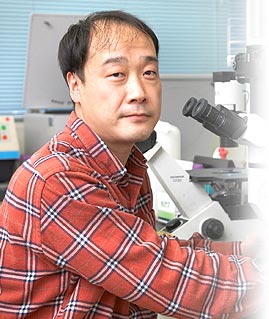

Center for AIDS Research, Associate Professor
Immunology, Ph.D. Member of Committee for Education of Young Scientists, Research on cellular immune responses in HIV infection

 |

CD8+ T lymphocytes (CTLs) recognize HIV-infected cells by interaction of their own T cell receptors (TCRs) with viral peptides bound to HLA class I molecules in the surface of the infected cells and eliminate them directly by cytolysis or indirectly through the production of soluble factors such as cytokines and chemokines. Although virus-specific CTLs play a critical role in the control of persistent virus infections including those by HIV-1, it is not completely clear why viral replication persists and progressive immunodeficiency generally ensues. A key observation is that significant difference exist in the effectiveness of HIV-specific CTLs among different specificities and TCR clonotypes within the same specificity. Another key is that mutational escape of HIV-1 from established CTL responses occurs in individual human hosts. |
We have postulated that these events alone or cooperatively result in a generation of less effective CD8 T cells that could undermine their control of HIV-1 replication in vivo. Thus, our team (2 Ph.D. students and me) are currently working on the following research projects:
|
(1) |
Whether and if so, how antiviral activity of CTLs is influenced through interactions of their TCRs, viral peptides, and HLA class I restriction elements. |
|
(2) |
Whether and if so, how CTL-mediated selective forces affect biological functions of Nef, a pathogenic protein of HIV-1 that can enhance viral replication.
It is pleased that another Ph.D student has just joined us from this October. He has started to address another aspect of the related questions and is trying to open up new venues in the field. |
|
 |

♦Selected references of our recent works:
|
|
1. |
Takamasa Ueno,Chihiro Motozono, Sachi Dohki, Philip Mwimanzi, Susanne Rauch, Oliver T. Fackler, Shinichi, Oka, Masafumi Takiguchi (2008) CTL-mediated selective pressure influences dynamic evolution and pathogenic functions of HIV-1 Nef. Journal of Immunology 180, 1107-1116 |
|
2. |
Takamasa Ueno,Yuka Idegami, Chihiro Motozono, Shinichi, Oka, Masafumi Takiguchi (2007) Altering effects of antigenic variations in HIV-1 on antiviral effectiveness of HIV-specific CTLs. Journal of Immunology 178, 5513-5523 |
|
3. |
Takamasa Ueno,Hiroko Tomiyama, Mamoru Fujiwara, Shinichi, Oka, Masafumi Takiguchi (2004) Functionally impaired HIV-specific CD8 T cells show high affinity TCR-ligand interactions. Journal of Immunology 173, 5451-5457 |
|
4. |
Takamasa Ueno,Mamoru Fujiwara, Hiroko Tomiyama, Masafumi Onodera, Masafumi Takiguchi (2004) Reconstitution of anti-HIV effector functions of primary human CD8 T lymphocytes by transfer of HIV-specific αβ TCR genes. European Journal of Immunology 34, 3379-3388 |
|
5. |
Takamasa Ueno,Hiroko Tomiyama, Masafumi Takiguchi (2002) Single T cell receptor-mediated recognition of an identical HIV-derived peptide presented by multiple HLA class I molecules. Journal of Immunology 169, 4961-4969 |

 |
 |
|








